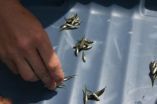(Press-News.org) A new study presented today at the European League Against Rheumatism Annual Congress (EULAR 2014) showed that obese patients with rheumatoid arthritis (RA) have higher DAS (disease activity) scores than non-obese patients, irrespective of their disease stage.1 With clinical remission as the ultimate therapeutic goal in RA,2 several studies have demonstrated that treatment to target – a treatment approach guided by its impact on reducing DAS scores – is more effective in lowering disease activity and, ultimately, reaching remission than usual care.3-7 Because obese patients have inflated DAS scores, treatment to target protocols may result in them being treated more aggressively than non-obese patients, which would explain the inverse relationship between body mass index (BMI)* and outcomes in RA.†
"Increasing levels of body fat are associated with heightened production of proinflammatory signalling proteins and raised levels of inflammatory markers. This systemic inflammation could inflate standard DAS scores and mean that obese patients receive more aggressive treatment than their non-obese counterpart," commented Dr. Christopher Sparks, Institute of Ageing and Chronic Disease, University of Liverpool, Liverpool, United Kingdom. "Not only do these results provide an explanation for the paradoxical relationship between BMI and disease outcome in RA, they clearly support the benefit to all RA patients of early and aggressive treatment."
RA is a chronic autoimmune disease that affects 0.3.0% of the general population; approximately one in 100 people worldwide. It is more prevalent among women than men, and more prevalent in developed countries.8 The symptoms of the disease, which include persistent inflammation, can lead to irreversible joint damage.
In this study, clinical data from an international RA database were used to identify an early (eRA, disease duration END
Higher disease activity scores in obese RA patients
New data support benefit of early, aggressive treatment of RA
2014-06-11
ELSE PRESS RELEASES FROM THIS DATE:
Newly discovered paddle prints show how ancient sea reptiles swam
2014-06-11
Trackways formed on an ancient seabed have shed new light on how nothosaurs, ancient marine reptiles that lived during the age of the dinosaurs, propelled themselves through water. The evidence is described by a team from Bristol and China in Nature Communications today.
During the Mesozoic, 252-66 million years ago, the seas were ruled by a variety of marine reptiles. One of the earliest groups were the nothosaurs, voracious semi-aquatic hunters with elongate bodies and paddle-like limbs. They were the top predators of the Triassic coasts, some 245 million years ago.
Their ...
Forest loss starves fish
2014-06-11
Debris from forests that washes into freshwater lakes supplements the diets of microscopic zooplankton and the fish that feed off them – creating larger and stronger fish, new research shows.
The researchers warn that, as forests are eroded through human activities such as logging, the impacts will be felt in aquatic as well as terrestrial food chains.
In fact, the study was conducted at a Canadian lake chosen because it had suffered ecological disaster during the mid-20th century: acid rain as a result of the local nickel smelting industry.
Despite moves to reduce ...
Sports teams may lose out from having 'too much talent'
2014-06-11
As the FIFA World Cup kicks off and the NBA finals "heat" up, new research suggests that there is such a thing as having too much talent on a sports team. The research indicates that, after a certain point, the addition of more superstar talent to a team can actually be detrimental, resulting in poorer team performance.
The findings are forthcoming in Psychological Science, a journal of the Association for Psychological Science.
The research, led by INSEAD Professor Roderick Swaab, showed that the presence of too many individuals with top talent can undermine players' ...
Nearby satellite galaxies don't fit standard model
2014-06-11
Satellite dwarf galaxies at the edges of the Milky Way and neighboring Andromeda defy the accepted model of galaxy formation, and recent attempts to pigeon-hole them into the model are flawed, an international team of scientists reports.
The mismatch raises questions about the accuracy of the standard model of cosmology, which is the widely accepted paradigm for the origin and evolution of the universe, the astrophysicists say.
A preprint of the research paper, accepted for publication by the Monthly Notices of the Royal Astronomical Society, is online at http://arxiv.org/abs/1406.1799.
The ...
Map of universe questioned; dwarf galaxies don't fit standard model
2014-06-11
Dwarf galaxies that orbit the Milky Way and the Andromeda galaxies defy the accepted model of galaxy formation, and recent attempts to wedge them into the model are flawed, reports an international team of astrophysicists.
David Merritt, professor of astrophysics at Rochester Institute of Technology, co-authored "Co-orbiting satellite galaxy structures are still in conflict with the distribution of primordial dwarf galaxies," to be published in an upcoming issue of Monthly Notices of the Royal Astronomical Society. A pre-print of the paper is available online at http://arxiv.org/abs/1406.1799.
The ...
Improvements in MRIs, other image-detection applications on the horizon
2014-06-11
LIVERMORE, Calif. — Researchers at Sandia National Laboratories, along with collaborators from Rice University and the Tokyo Institute of Technology, are developing new terahertz detectors based on carbon nanotubes that could lead to significant improvements in medical imaging, airport passenger screening, food inspection and other applications.
A paper in Nano Letters journal, "Carbon Nanotube Terahertz Detector," debuted in the May 29 edition of the publication's "Just Accepted Manuscripts" section. The paper describes a technique that uses carbon nanotubes to detect ...
Experts unlock key to blood vessel repair
2014-06-11
Scientists from the University of Leeds have found a way to restore the function of damaged blood vessel repairing cells, in a potentially important step for the future treatment of heart disease.
The research, part-funded by the British Heart Foundation (BHF), could also pave the way for new targets for drug development in the fight against heart disease.
The findings have also identified a potential reason why South Asian men in the UK experience an increased risk of heart disease.
Led by Dr Richard Cubbon in the School of Medicine, the research team studied cells ...
New research could provide key to overcoming resistance to HER2 targeted cancer treatments
2014-06-11
Dublin, Ireland, June 11th, 2014 – Scientists from the School of Pharmacy & Pharmaceutical Sciences, Trinity College Dublin have made a significant discovery of a new biomarker which may help overcome resistance to newer and more targeted anti-cancer drugs, such as Herceptin, for HER2 positive cancers. These findings may also help the early identification of patients who will benefit more from these treatments.
The researchers, led by Professor Lorraine O'Driscoll, Associate Professor of Pharmacology, Trinity, studied breast cancer cells and their extracellular vesicles ...
International team unearths genetic risk factor for type 2 diabetes in Latin American populations
2014-06-10
In the largest study of its kind published to date, an international team of researchers in Mexico and the United States has discovered a strong genetic risk factor for type 2 diabetes that primarily affects Latin American patients, but is rare elsewhere. The work further characterizes a gene called HNF1A, responsible for a rare, inherited form of diabetes against which a widely available and inexpensive class of drugs is highly effective. The discovery offers important new clues about the population genetics of type 2 diabetes in Latin American populations, and suggests ...
NREL finds up to 6-cent per kilowatt-hour extra value with concentrated solar power
2014-06-10
Concentrating Solar Power (CSP) projects would add additional value of 5 or 6 cents per kilowatt hour to utility-scale solar energy in California where 33 percent renewables will be mandated in six years, a new report by the Energy Department's National Renewable Energy Laboratory has found.
The report, "Estimating the Value of Utility-Scale Solar Technologies in California Under a 40% Renewable Portfolio StandardPDF," finds that CSP, with its ability to store energy for several hours or more, helps maintain firm capacity in the hours when the sun is below the horizon. ...
LAST 30 PRESS RELEASES:
Roadmap for reducing, reusing, and recycling in space
Long-term HIV control: Could this combination therapy be the key?
Home hospital care demonstrates success in rural communities
Hospital-level care at home for adults living in rural settings
Health care access outcomes for immigrant children and state insurance policy
Change in weight status from childhood to young adulthood and risk of adult coronary heart disease
Researchers discover latent antimicrobial resistance across the world
Machine learning identifies senescence-inducing compound for p16-positive cancer cells
New SwRI laboratory to study the origins of planetary systems
Singing mice speak volumes
Tiny metal particles show promise for targeted cancer treatments
How supplemental feeding boosts reproductive conditions of urban squirrels
Insomnia combined with sleep apnea is associated with worse memory in older women
New AI could teach the next generation of surgeons
Study reveals alarming number of invasive breast cancers in younger women
‘beer belly’ linked to heart damage in men
Mini lung organoids made in bulk could help test personalized cancer treatments
New guideline on pre-exposure and postexposure HIV prevention
“Lung cancer should no longer be defined by fear and stigma,” experts say
Palliative care for adolescents and young adults with cancer
Cu (100) grain boundaries are key to efficient CO electroreduction on commercial copper
Cobalt-induced asymmetric electron distribution boosts photocatalytic hydrogen production efficiency
Ultra-low doping 0.1(PtMnFeCoNi)/TiO2 catalysts: Modulating the electronic states of active metal sites to enhance CO oxidation through high entropy strategy
Clinical use of nitrous oxide could help treat depression, major study shows
Report reveals potential of AI to help Higher Education sector assess its research more efficiently and fairly
Corporate social responsibility acts as an insurance policy when companies cut jobs and benefits during the times of crisis
Study finds gender gap in knee injuries
First ‘Bible map’ published 500 years ago still influences how we think about borders
Why metabolism matters in Fanconi anemia
Caribbean rainfall driven by shifting long-term patterns in the Atlantic high-pressure system, study finds
[Press-News.org] Higher disease activity scores in obese RA patientsNew data support benefit of early, aggressive treatment of RA



